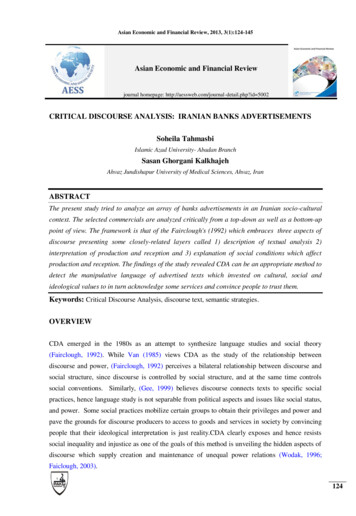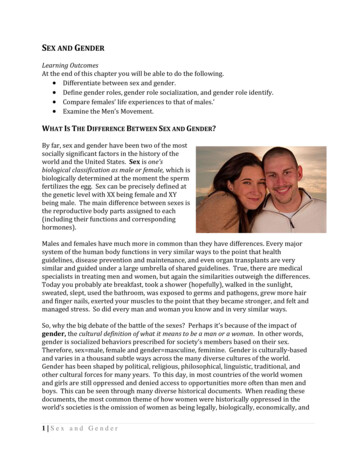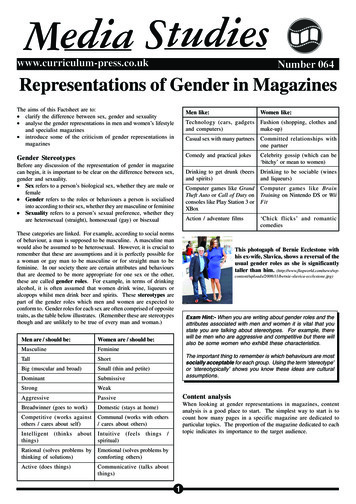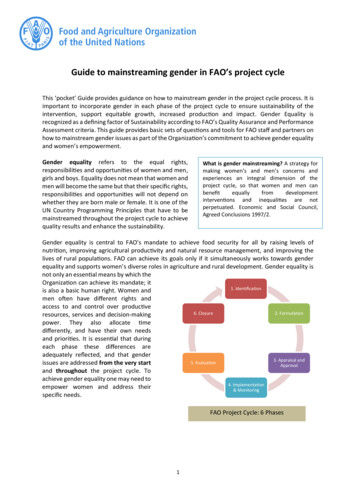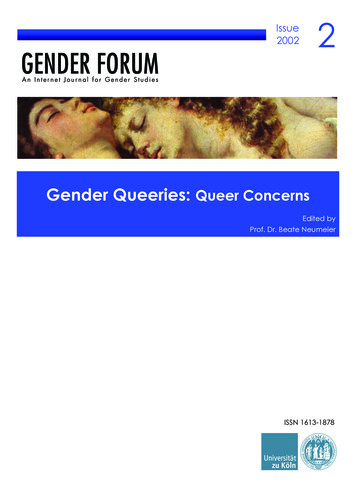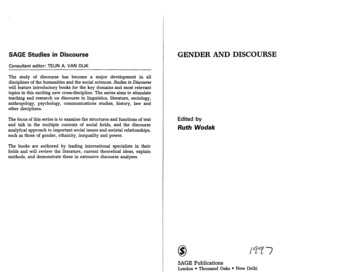
Transcription
SAGE Studies in DiscourseGENDER AND DISCOURSEConsultant editor: TEUN A. VAN DIJKThe study of discourse has become a major development in alldisciplines of the humanities and the social sciences. Studies in Discoursewill feature introductory books for the key domains and most relevanttopics in this exciting new cross-discipline. The series aims to stimulateteaching and research on discourse in linguistics, literature, sociology,anthropology, psychology, communications studies, history, law andother disciplines.The focus of this series is to examine the structures and functions of textand talk in the multiple contexts of social fields, and the discourseanalytical approach to important social issues and societal relationships,such as those of gender, ethnicity, inequality and power.Edited byRuth WodakThe books are authored by leading international specialists in theirfields and will review the literature, current theoretical ideas, explainmethods, and demonstrate these in extensive discourse analyses.@111,;SAGE PublicationsLondon Thousand Oaks New Delhi
80GENDER AND DISCOURSEand the privilege of partial perspective', in Donna Haraway, Simians, Cyborgs,and Women. London: Free Association Books. pp. 183-201.Harding, Sandra (1986) The Science Question in Feminism. Ithaca, NY: CornellUniversity Press.Haug, Wolfgang Fritz (1984) Die Camera Obscura des Bewuf,tseins: Kritik derSubjekt/Objekt-Artikulation im Marxismus. Berlin: Argument-Verlag.Holzkamp, Klaus (1983) Grundlegung der Psychologie. Frankfurt am Main:Campus.Kitzinger, Celia and Thomas, Alison (1995) ISexual harassment: a discursiveapproach', in Sue Wilkinson and Celia Kitzinger (eds), Feminism and Discourse:Psychological Perspectives. London, Thousand Oaks, New Delhi: Sage. pp. 32 4GENDER AND LANGUAGE IN THEWORKPLACEShari Kendall and Deborah Tannen40.Laclau, Ernesto (1981) ILa politique comme construction de l'impensable', in B.Conein et ale (eds), Materialites discuTsives. Litle. pp. 65-74.List, Elisabeth (1993) Die Priisenz des AndeTen: Theone und Geschlechterpolitik.Frankfurt am Main: Suhrkamp.Lovering, Kathryn Matthews (1995) 'The bleeding body: adolescents talk aboutmenstruation', in Sue Wilkinson and Celia Kitzinger (eds), Feminism andDiscourse: Psychological Perspectives. London, Thousand Oaks, New Delhi:Sage. pp. 10-31.Lutz, Helma (1989) 'Unsichtbare Schatten? Die 'orientalische Frau in westlichenDiskursen - Zur Konzeptualisierung einer Opferfigur', Periphene, 37: 51-65.Lutz, Helma (1992) Welten verbinden, Tiirkische Sozialarbeiterinnen in denNiederlanden und der Bundesrepublik Deutschland. Frankfurt am Main: IKO.Marx, Karl (1970) 'Briefe aus den "deutsch-franzOsischenJahrbiichem"', in KarlMarx, Friedrich Engels: Werke, vol. I. Berlin: Dietz.Verlag. pp. 337-46.Potter, Jonathan and Wetherell, Margaret (1987) Discourse and Social Psychology.London: Sage.Rathzel, Nora t199S) 'Images of Heimat and images of "Auslander"', inAleksandra Aslund and Raoul Granqvist (eds), Negotiating Identities.Amsterdam. pp. 45-68.Smith, Dorothy (1981) 'The experienced world as problematic: a feministmethod'. Sorokin Lecture no. 12. Saskatoon: University of Saskatchewan.van Dijk, Teun (1987) Communicating Racism: Ethnic Prejudice in Thought andTalk. London: Sage.van Dijk, Teun (1991) Racism and the Press. London: Routledge.van Dijk, Teun (1993) Elite Discourse and Racism. London: Sage.van Dijk, Teun (1996) Discourse, Racism and Ideology. La Laguna: RCEI Ediciones.Wetherell, Margaret and Potter, Jonathan (1992) Mapping the Language ofRacism.New York: Columbia University Press.Widdicombe, Sue (1995) 'Identity, politics and talk: a case for the mundane andthe everyday', in Sue Wilkinson and Celia Kitzinger(eds), Feminism andDiscourse: Psychological Perspectives. London: Sage. pp. 106-27.Wodak, Ruth (1995) 'The genesis of racist discourse in Austria since 1989', inCarmen Rosa Caldas.Coulthard and Malcom Coulthard (eds), Reading inCritical Discourse Analysis. London: Routledge. pp. 107-28.Interaction in the workplace is characterized by a unique constel lation of constraints: an institutional structure in which individualsare hierarchically ranked; a history of greater male participation inmost work settings, especially at the higher ranking levels; a stillexisting, though recently permeated, pattern of participation alonggender lines; periodic external evaluation in the form of raises, pro motions, task assignments, and performance reviews; and a situationin which participants are required to interact regularly with otherswho are neither kin nor chosen affiliates. The workplace thusprovides a special challenge to gender and language researchers aswell as an opportunity to observe interaction in the context of theseconstraints.Research on language in the workplace has focused primarily on task related talk among professionals and lay persons. The majority ofresearch on gender and language in the workplace has retained thisfocus, with a handful of studies branching out to examine talk amongco-workers and among professionals. In addition, a few studies haveconsidered the use and importance of non-task-related talk in theworkplace. For example, Tannen (1994a) notes the importance ofinformal talk to getting work done and receiving opportunities neededfor advancement. Bates (1988) finds that informal use of military,athletic, and sexual language in the workplace produces a subtleseparation betv.teen women and men, and alienates those who do notparticipate in the use of sexual language from the informal powerstructure in the organization.These studies notwithstanding, the research on gender and languagein the workplace falls primarily into two categories, based on the workroles of, and relationships among, speakers. In the first category arestudies that address how women and men interact with each other atwork. In the second are studies that focus on how women and menenact authority in professional positions. A third area of investigation,addressed in many of the studies in the two preceding categories, is the
82GENDER AND DISCOURSEeffect of women's and men's language use on how they are evaluatedand reacted to.In the present chapter, we will review representative sources in eachof these areas and then suggest that the theoretical and methodologicalapproach of framing is a particularly useful one for understanding theinterrelation of gender and power in the workplace. This claim issupported by reference to the authors' research.Pioneering work on gender and language stems from the feministmovement of the 1960s and 19705, reflecting notions of social roles thatwere current then (Lakoff, 1975; Thorne and Henley, 1975; McConnell Ginet et al., 1980). As attention turned to the investigation of genderitself (see Cameron, 1997), discourse and gender research shifted to a'social construction' paradigm. Recent volumes that advocate thisposition are Crawford (1995), Hall and Bucholtz (1995), and Johnsonand Meinhof (1997). In this paradigm, gendered identities - and otheraspects of social identity - are maintained and (re-)created throughsocial practices, including language practices. Individuals are activeproducers of gendered identities rather than passive reproducers ofsocialized gender behaviour. The framing approach advocated in thischapter provides a powerful theoretical and methodological approachthat accounts for, and explicates, how language practices and genderedidentities are dynamically linked in interaction.Women and men actively choose ways of framing to accomplishspecific ends within particular interaction. These choices are drawn, inpart, from sociocultural norms for how women and men are expectedto accomplish such actions through talk. Individuals' language choices,in the local interaction, invoke these gendered norms and, thus,perform gendered identities as well. Gendered ways of framing are, inthis sense, resources for accomplishing the speakers' purpose. Thismodel accounts for the observation that many women and men do notconstruct gendered identities in ways consistent with gender-relatedcultural norms. Likewise, it accounts for the fact that behaviour thattransgresses such norms may be perceived in respect to these norms,which provide a 'rigid regulatory frame' for women's and men'sbehaviour (Cameron 1997: 49). As Bem (1993) describes, gender normsinclude a lens of 'gender polarization' - the ideology that women's andmen's behaviour is dichotomous. When viewed through this lens,women and men who diverge from gender norms may be perceivedas speaking and behaving 'like the other sex'. Furthermore, if womenand men do speak in similar ways, they are likely to be evaluateddifferently (Tannen, 1994a; West, 1995). Norms for gendered languageuse are, therefore, constraints as well as resources (Cameron, 1997;Hall and Bucholtz, 1995; Johnson, 1997; Ochs, 1992; Tannen, 1994a;1994b; West and Zimmerman, 1987). As Erickson (1995) puts it, 'Thereis human agency, but it can only be exercised in a world of socialgravity.'GENDER AND LANGUAGE IN THE WORKPLACE83How women and men interact in groupsResearch on how women and men interact with each other at work hastended to focus on amount of participation and influence. The researchsuggests that, in groups, men tend to get and keep the floor more oftenthan women, talk more often and for longer, interrupt more, and makedifferent kinds of contributions, using language strategies that challenge,create and maintain status distinctions (i.e. they create and maintainasymmetrical alignments between themselves and interlocutors).Women, according to this research, tend to get and keep the floor lessfrequently and for less time, interrupt less, and use language strategiesthat are more supportive and that minimize status distinctions.A sense of this research may be gleaned by considering the phenom enon of interruption, one of the most widely investigated languagebehaviours in general as well as in the gender and language literature.Despite the highly complex nature of determining when an interruptionoccurred, and the equally if not more complex nature of determining itsintention and effect (these are discussed in Tannen, 1994cJ, most studiessimply count interruptions and make the overly simplified conclusionthat the 'interrupted' is disadvantaged. James and Clarke (1993) reviewthe literature that appeared between 1965 and 1991 on gender differ ences in interruption and note radical differences in definitions, andhence identifications, of interruption. They conclude, nonetheless, thatmost research has found no significant difference between the gendersin number of interruptions initiated, in either cross-sex or same-sexinteraction, even when taking into account the content of the inter ruption relative to the interrupted's talk, whether the interruptionoccurs in unstructured conversations or conversations in seminars orwork groups, and whether the researcher differentiates between sup portive or disruptive interruptions. Keeping Tannen (1994c) and Jamesand Clarke (1993) in mind as cautionary tales, we nonetheless canobserve that a review of research on gender and workplace interactionsuggests some potential, albeit inconclusive, patterns. Workplacestudies (some of which are reviewed below) that compare the frequencyof men's and women's interruptions in mixed-sex groups suggest thatmen may interrupt women more frequently in these contexts, althoughthe results vary. Studies (reviewed below) comparing how often pro fessional women and men interrupt, or are interrupted by, lay personssuggest that men professionals may interrupt clients more frequently,and that women professionals may be interrupted more often than menin the same position. Similarly, in a study of the conversationalinteraction of women and men managers working in groups of ten at amanagement school, Case (1985; 1988) finds that the men managerstend to interrupt more than the women managers.Two classic studies set the stage for investigations of how women andmen tend to interact with each other in groups in the workplace. Eakins
84GENDER AND DISCOURSEand Eakins (1976) analysed seven university faculty meetings, andfound that the men spoke more often and for longer than the women,and that each of the men in the faculty meetings interrupted more oftenthan each of the women, even when taking into account the totalnumber of twns taken. Edelsky ([1981] 1993) analysed five universityfaculty meetings and found that during the more structured segments,there were few interruptions but men took longer twns than thewomen.More recent studies examine the nature of turns. Case (1985; 1988), forexample, found that women and men managers tend to make differenttypes of contributions in groups. She assessed the frequency of 34gender-related speech variables in each of the managers' speeches,creating a speech profile for each manager. Then, using statisticalanalysis, she identified two predominant speech styles that correlatedwith sex. Based on the types of strategies used in these styles, shecharacterized the style used primarily by women as a facilitative,personal style, and the style used primarily by men as an assertive,authoritative style. She found that the men tended to use more strategiesof display such as joking, swearing, using slang, and talking aboutcompetition and aggression, as well as more of the strategies that appealto authority and maintain status distinctions, such as appealing toobjectivity instead of personal experience and giving direct commands.(See Goodwin, 1990, for a discussion of boys' use of commands and howthis type of directive creates and maintains status distinctions.) Thewomen tended to use more strategies that engaged others and mjnimizedstatus differences, such as backchannelling, adding to others' commentsto shift topics, and using modal constructions rather than imperatives.These results are similar to those that Tannen (1994a) describes forinteractions that she observed and analysed in several large corpora tions. She found that some men were more likely to speak in ways thatclaimed attention and got credit for their contributions, whereas womenwere more likely to preface statements with a disclaimer, speak at alower volume, and try to be succinct so as not to take up more speakingtime than necessary, especially at meetings. Tannen found that womenand men tended to make different kinds of contributions as well, based,in part, on having different conventionalized ways of exploring ideas.More men than women used an oppositional format to accomplish arange of interactional goals, including the discussion of ideas. Accordingto Tannen, those who use this style view challenge and debate asnecessary for developing and strengthening ideas. Many women who donot engage in ritual opposition may take such challenges literally, asindication of weaknesses in their ideas, or as personal attacks; more.over, they may find it impossible to do their best in what they perceiveas a contentious environment.Case (1994) and Tannen (1994a) argue that when women and meninteract in groups, a mismatch in the styles that they typically use isGENDER AND LANGUAGE IN THE WORKPLACE85likely to produce unbalanced participation, so that those who end uphaving proportionately more influence in groups and appearing morecompetent and capable (and hence wielding more authority) are morelikely to be men. Tannen suggests that when one speaker approaches a,: - discussion through an oppositional format and the other approaches it: in ways that maintain the appearance of equality, the latter (who is';"-more likely to be female) is at a disadvantage. Likewise, Case argues,that men's interactional styles in organizations currently work to their/- advantage by leading to domination of talk and increased influence in:-;'- ecision-making in groups. Tannen also points out that women beginr-.With a disadvantage in workplaces that have previously had men in positions of power because these workplaces already have established'-Ymale.style interaction as the norm.J- t The insight that styles of interaction more common among men have-become the workplace norm again builds on the pioneering study ofEdelsky ([1981] 1993). In the faculty committee meetings Edelsky taped,- ethe women participated more equally in unstructured and informal\parts of the meeting - portions that are not institutionalized and do not,carry as much authority in the organization. In a review of the litera·:ture that appeared between 1951 and 1991 on gender differences in;,':8mount of talk, James and Drakich (1993) found a pattern that alludes:: to the connection between institutionalized interaction in the workplacer-and male norms of interaction. The studies they reviewed suggest that:. men talk more in formal task-oriented contexts or other formally struc '. tured contexts - a description that applies to key workplace settings whereas women are likely to talk as much or more in informalcontexts.;:/.:!!' Some studies have investigated the interaction of women in all ;. women groups, revealing some interesting comparisons with the: ;, patterns found in groups of women and men. Linde (1991) examined""c how two women who are equal partners in a design fum managed the(i agenda in one face. to-face meeting and in three telephone meetings.";;Linde notes that the women negotiated the topics equally even though;,;there was no formal prior agenda and no specified chair for the meeting. -She found that, in the meetings, the women 'are careful to negotiateclosings which are agreed to by both parties and are not abrupt. Pre /closings are extensive, which assures that both participants have had-:1heir say, before a current topic is concluded. Similarly, the introductiontof new topics is negotiated, rather than unilaterally announced or begun''(1991: 310). Although Linde does not discuss gender as a potential,; influence on how these women negotiated topics, their topic shifts are-similar to the reciprocal shifts that Ainsworth-Vaughn (1992) foundwomen doctors tended to use with their patients, which contrasted with: ;the unilateral shifts that the men doctors used more often.In summary, studies that address how women and men interact witheach other at work suggest that men tend to get and keep the floor more1:c
86GENDER AND DISCOURSEoften and for longer than do women in formal task-oriented contexts,and that women and men tend to use language strategies that perform,different interactional functions and create different alignments'between themselves and other participants.How women and men enact professional authorityMany of the studies reviewed above take as their starting point thatworkplace norms are masculine norms, owing to the historically greaterparticipation of men in these professions, the current numerical'predominance of men at higher levels, andlor the cultural interpreta-i:tions of given types of work that dictate who is thought to be best suited for that work. (See McElhinny, 1993, for a discussion of the cultural,interpretations of types of work that result in one or the other gender. being regarded as being best suited for a given type.) This research:focus is motivated, in part, by discussions of the links betweenlanguage, gender, and power. For example, Lakoff explains that thenorms of men's discourse styles are institutionalized, that they are seen:'not only as 'the better way to talk but as the only way' (1990: 210). Galargues that men's discourse styles are institutionalized as ways of speaking with authority, that institutions are 'organized to define,::demonstrate, and enforce the legitimacy and authority of linguisticstrategies used by one gender - or men of one class or ethnic group while denying the power of others' (1991: lSB).Given these findings, it is not surprising that many studies havefocused on women in professions in which women have not tradi tionally been significantly represented. In particular, numerous studieshave addressed the question of whether women and men enact auth ority in these professions in ways similar to their male counterparts.The majority of studies conclude that women adopt some of thepractices associated with the profession that have been established bymen while adapting others. For example, McElhinny found that thewomen police officers she observed project a 'police officer' identity byadopting discourse management techniques that portray 'facelessness inface-to-face interaction' (1995: 236). But they also adapt interactionalnorms of policing by projecting a more middle-class image of a policeofficer who is rational, efficient, and professional, rather than theworking-class image of the police officer that is centred on displays ofphysical force and emotional aggression (1995: 219-20).West (1984; 1990), Pizzini (1991), Ainsworth-Vaughn (1992), andFisher (1993) consider how women and men physicians interact with i!;patients. West (1984) finds that, although doctors generally interrupt ,:patients more frequently than the reverse, when women doctors see}men patients, it is the doctors who are interrupted more often. West(1990) analysed directive-response sequences in medical encounters.GENDER AND LANGUAGE IN THE WORKPLACE87,:-,She found that men doctors tended to give aggravated directives that-\explicitly establish status differences, whereas women doctors tended to',JDitigate their commands, using directive forms that minimize status;distinctions between themselves and their patients. West concludes thatj;'Women are constituting the role of physician in a way that exercises less' teractional power than men physicians typically exercise.- ' ::-Pizzini (1991) compares women and men gynaecologists' use ofhumour in gynaecological exams. She found that both the women andJhe men used humour to interrupt their patients, but the men inter ,rupted their patients more frequently. Furthermore, the men tended to se interrupting humour to reestablish their scientiftc authority, :whereas the women did so to discontinue discussions they considered:11D.Ilecessary. ,Ainsworth-Vaughn (1992) found that women doctors she observeddownplayed status differences by using reciprocal topic shifts that share, teractional power between doctor and patient, whereas men doctorstended to shift topics unilaterally, without waiting for patient agree ment. She concludes that men and women physicians realize greater Ptteractiona1 power vis-a-vis their patients than do women physicians,\and predicts that 'the ways women constitute being a woman physician will surely affect social and sociolinguistic norms for the role and for-the encounter' (1992: 424).t 1:t,Fisher (1993) contrasts the medical consultation of a (woman) nurse{practitioner with the consultation of a (man) doctor to assess whether"purse practitioners, who claim. to bring caring to the practice of medi ;cine, minimize the asymmetry in the provider-patient relationship. She concludes that the doctor recreates his status as medical expert byasking narrowly focused questions and by moving rapidly to diagnosticclosure. The nurse practitioner, in contrast, simultaneously reinforcesher authority and 'distances herself from it, minimizing her professional,status' (1993: 102) by establishing and maintaining a gender-based,:,solidarity, asking open-ended questions, and not moving rapidly towarddiagnostic closure. In this way, the nurse practitioner refrains fromimposing her medical expertise and her definition of the situation, andlegitimates the patient's feelings.c In each of these studies, women physicians speak in ways thatGminjrnize status differences and downplay their own authority. These fmdings make a significant contribution to the language and workplace: -literature, much of which focuses on interactional asymmetries in',interactions between professionals and lay persons. Based on the:,research presented in their collection, Drew and Heritage conclude that:;!In many forms of institutional discourse . . . there is a direct relation ship between status and role, on the one hand, and discursive rights and ;'-cobligations, on the other' (1992: 49). The linguistic behaviour of the::-;:.:women physicians reported in the studies described above suggest that, &d /a1though a connection between status/role and discursive rights and
88GENDER AND DISCOURSEobligation exists, this relationship is mediated by gender-relatedpatterns as well.Those studies that mentioned effectiveness found that the women'sstrategies were actually more effective in these contexts. In Fisher(1993), the doctor and his patient never reached agreement on the causeof or treatment for her condition, but the nurse practitioner and herpatient reached a compromise agreement. West (1990) found that more'polite' directive produced more compliant responses and, sincewomen doctors used more of the polite directives, they had a greaterrate of compliance from patients overalLResearchers have also focused on how women and men enact auth ority in managerial positions. Tannen (1994a), Horikawa et ale (1991),and Tracy and Eisenberg (1990/1991) investigate how superiors giveorders to subordinates. Patterning much as physicians were shown tospeak with their patients, the men superiors in these studies tended tospeak in ways that maintain or maximize status differences, whereasthe women superiors tended to speak in ways that minimize statusdifferences.In her analysis of women and men in corporations, Tannen (1994a)notes that the women she observed in positions of authority tended togive directives to subordinates in ways that saved face for thesubordinate, whereas many men in similar positions tended not to givedirectives in this way. However, Tannen cautions against assuming thattalking in an indirect way necessarily reveals powerlessness, lack ofself-confidence, or anything else about the internal state of the speaker.Indirectness, she notes, is a fundamental element in human commu nication and one that varies significantly from one culture to another.Although women in her study were more likely to be indirect whentelling others what to do, she suggests that their motivation may be tosave face for their interlocutors, especially subordinate interlocutors.Men were also often indirect, but in different situations and in differentways. For example, many men tended to be indirect when revealingweaknesses, problems, or errors, and when expressing emotions otherthan anger (1994a: 90). Tannen explains that those who would not useindirectness in a particular way often misjudge those who use it in thatway. Those who expend effort to save face for a subordinate including indirect approaches - can be seen as being manipulative orsomehow less than honest.Using an experimental design, Horikawa et ale (1991) investigate theeffects of request legitimacy on the directness and politeness of womenand men managers' compliance-gaining tactics. They asked women andmen managers to report what they would say if they had to cancel asubordinate's vacation in one of two scenarios. In one scenario, themanager had no formal right to request that the subordinate cancel thevacation, so the manager needed to gain the compliance of the sub ordinate; in the other scenario, company policy gave the manager theGENDER AND LANGUAGE IN THE WORKPLACE89right to cancel the vacation and, therefore, the manager did not need togain the subordinate's compliance. Horikawa et ale found that thestrategies that both women and men managers said they would usewere less direct and more polite when they needed to gain thesubordinate's compliance. However, when the managers did not needto gain the subordinate's compliance, the women managers used lessdirect and more polite requests than the men; in other words, if thesemanagers would actually speak the way they said they would, thewomen would expend linguistic effort to protect the face of the sub ordinate even when the subordinate is obligated to comply.Tracy and Eisenberg (1990/1991) conducted a role-play experiment ,-which suggests that women in positions of authority expend linguistic"- 'effort to save face for their subordinates. Twenty-four dyads of college ; - students, all of whom had work experience, were asked to orally- criticize letters written by another. In one situation, the student role played a supervisor giving feedback to an employee; in the other, thestudent role-played a subordinate giving feedback to a superior. Naivejudges completed questionnaires rating each of the speakers in terms ofthe degree to which their criticism was concerned with clarity and attention to face. Strategies rated high in attention to face includedpositive initial statements prefacing negative comments, positiveendings, and explanations for the criticisms. Strategies rated as low inattention to face included statements magnifying the size of the problemand blatant face attacks such as n e-ealling, unqualifred statementsabout the worthlessness of the work, and strong reprimands for minorerrors. Tracy and Eisenberg note that the women were significantlymore concerned about the other's face when they were in the superior role than when they were in the subordinate role.Nelson (1988) demonstrates a similar pattern in which a higher status'-woman supports women of lower status. She describes the interaction;:t between herself (a professor) and graduate teaching assistants in small-- groups intended to discuss and improve the assistants' teaching. Nelson,reports that she 'tried to minimize authoritarian behavior' by modelling';ways of phrasing criticism that avoided 'making light of any writer or her work' and by herself using the strategies that she wanted toencourage: praising others, focusing attention on others' strengths,:being emotionally open in revealing weaknesses, and involving others}in decision-making (1988: 202, 201).'1'shAll of these studies indicate that how women and men in positions of(authority spe
than women, talk more often and for longer, interrupt more, and make different kinds of c

